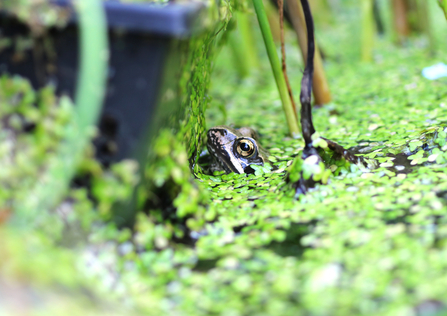
Ox-eye daisy, red campion, meadow buttercup and wild carrot growing in May 2021 in a wildflower verge in Whitchurch established by BBOWT's Hedgerow Havens project. Picture: Caroline Heron
A few well-chosen plants transform Ed's front garden

Ox-eye daisy, red campion, meadow buttercup and wild carrot growing in May 2021 in a wildflower verge in Whitchurch established by BBOWT's Hedgerow Havens project. Picture: Caroline Heron
Are you dreaming of colourful wild flowers? Start planning your garden now by choosing which seeds to sow and where. For swathes of wild flowers you’ll need to take off nutrient-rich topsoil, to create the right conditions for sowing seed in March. Choose a few areas in borders, under trees and on the veg plot to sow wildflower seed among the shrubs.
Cornfield flowers such as corncockle, cornflowers, poppy, and corn marigolds will bring pollinators to your garden.
If you have roses, now is a good time to prune them back.
A lacewing nesting box filled with straw and placed by your fruit trees will attract these useful insects, who will munch away those unwanted pests.
Flower power: Grow a miniature meadow (https://youtu.be/2VWdJTJKvIE)
Flower power: Grow a miniature meadow

A frog in a garden pond dug during the coronavirus lockdown by Helen Touchard-Paxton - winner of the Team Wilder category in the BBOWT Photography Competition 2022.
Celebrate World Wetlands Day (on 2 February) by creating a mini-wetland in your garden. A pond will attract lots of wildlife very quickly and give you hours of pleasure watching it.
If it’s too cold to dig just now, choose a site that’s part sunny and level which you can see from the house to start as soon as the weather’s better. Always remember to add an escape ramp to your pond, running parallel to its sides, so that any wildlife can get out of the pond.
Build a garden pond (https://youtu.be/NPwEvxYhfSg)
Create a wildlife pond

Leave an untidy corner in your garden to allow nettles to grow; they are an invaluable food source for some caterpillars. Some of these will be fed to chicks in spring, helping your garden birds, too.

Buff-tailed BumbleBee © Jon Hawkins Surrey Hills Photography
To create a simple bumblebee nest for emerging queens, take an upturned terracotta plant pot, fill it up with dry moss, leaves, and coir from an old mat, and place it in a shaded, sheltered spot taking care to leave a half inch gap at the bottom for access.
Bumblebees also love nesting in rockeries and wherever there is a gap into a cavity offering shelter and protection – patios, old bird boxes and air vents are also preferred spots.